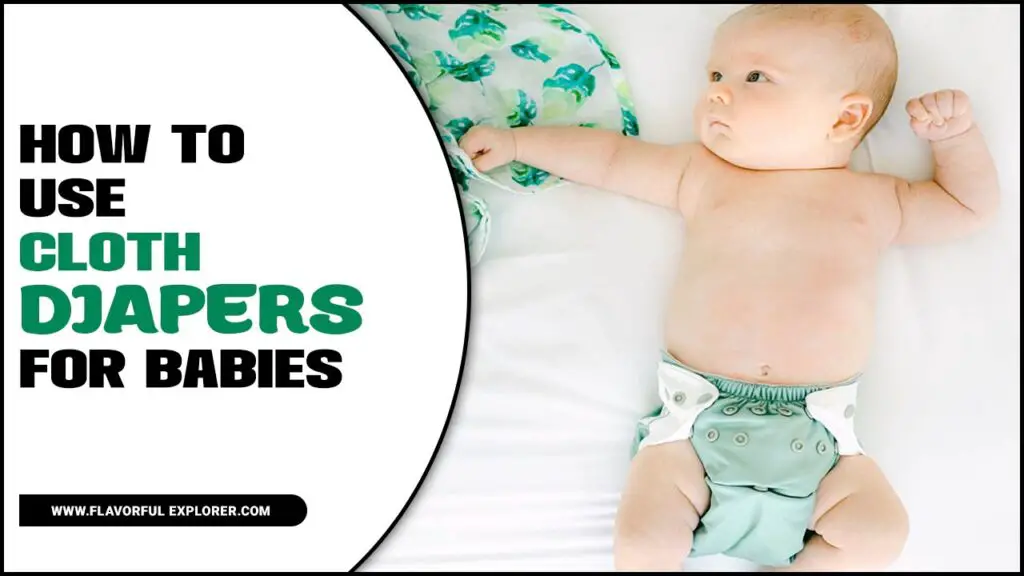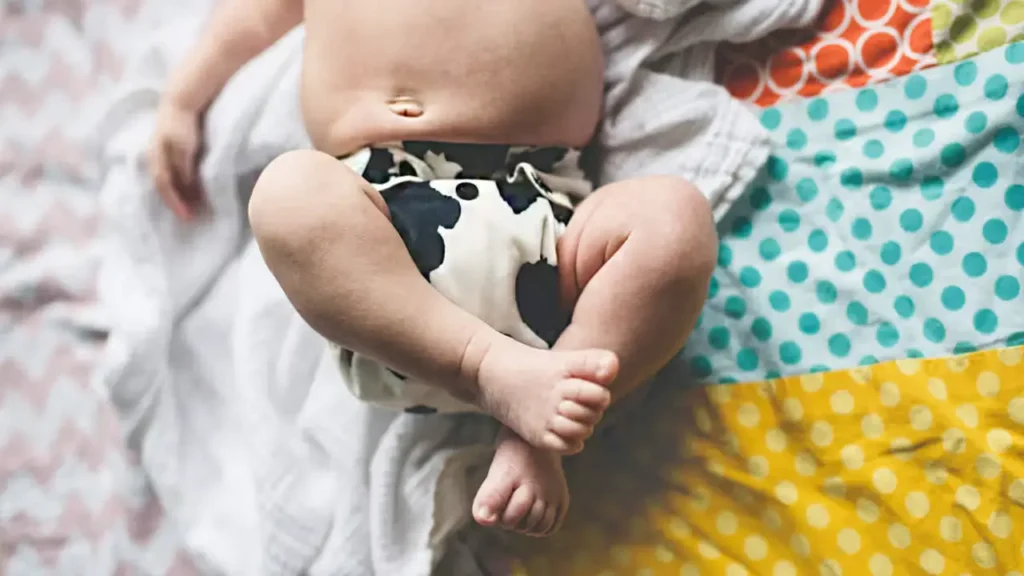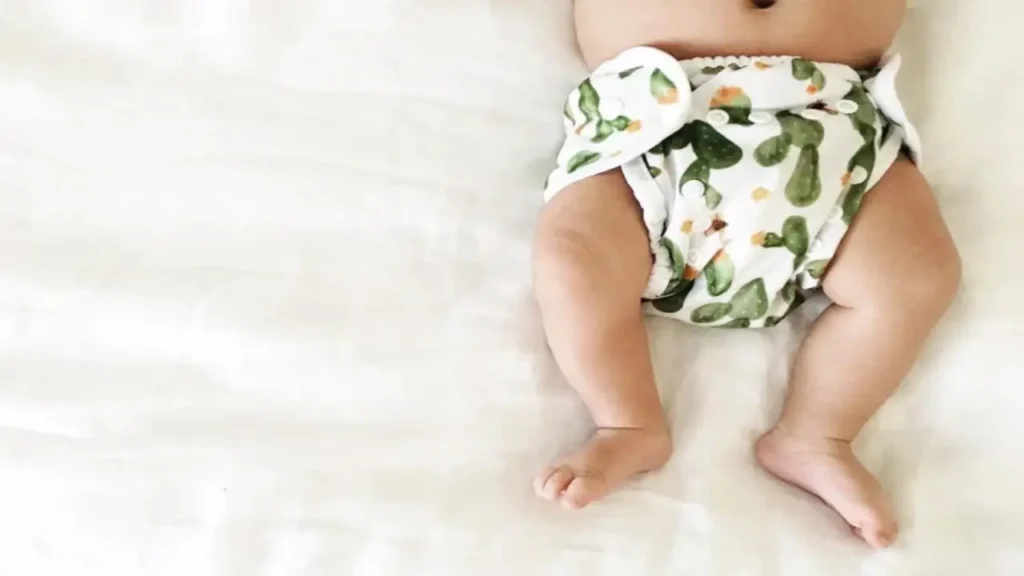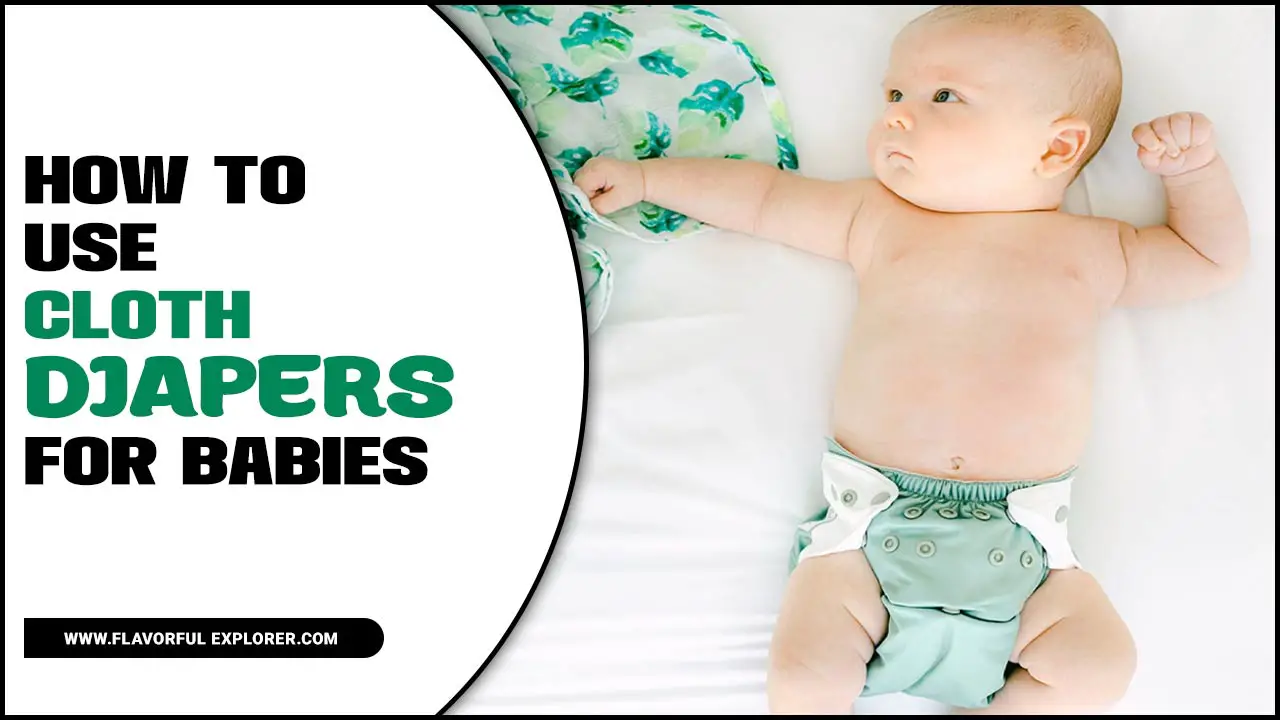Cloth diapers may seem like a thing of the past, but with growing concerns about environmental impact and chemical exposure, they are making a comeback in baby care. Not only are they more eco-friendly, but they can also save parents a significant amount of money in the long run. However, using cloth diapers may seem daunting and overwhelming for new parents.
Here, we will provide a comprehensive guide on how to use cloth diapers for babies, breaking down the process step by step and addressing common concerns and misconceptions. With the right knowledge and resources, using cloth diapers can be a simple and rewarding experience for you and your baby.

What Is Cloth Diapers?
Cloth diapers, also known as reusable diapers, are an alternative to disposable diapers that have gained popularity among environmentally conscious parents. These diapers are made from soft, absorbent fabrics such as cotton, bamboo, or hemp and are designed to be washed and reused multiple times.
One of the main benefits of cloth diapers is their eco-friendliness. Unlike disposable diapers, which contribute to the ever-growing landfill waste, cloth diapers can be used for years, reducing the environmental impact. Additionally, cloth diapers are free from harmful chemicals and additives commonly found in disposable diapers, making them a safer and healthier choice for babies sensitive skin.
How To Use Cloth Diapers For Babies – 4 Easy Steps

Using cloth diapers for babies is a sustainable and eco-friendly choice that many parents are opting for. Not only are cloth diapers better for the environment, but they are also gentle on your baby’s delicate skin. However, for new parents, using cloth diapers can seem daunting. But with a few simple steps and helpful tips, you can easily navigate the cloth diapering world.
The first step is to choose the right type of cloth diaper for your baby. Various options include pre-folds, fitted diapers, pocket diapers, and all-in-one diapers. Each type has advantages and disadvantages, so it’s important to research and find what works best for you and your baby. Here are five easy steps on how to use cloth diapers for babies:
1. Prepping The Diapers
Wash and dry them at least once before using cloth diapers for the first time to enhance their absorbency. This initial step is crucial as it helps remove any manufacturing residues and prepares the cloth diapers for optimal use. When putting on the cloth diapers, lay the diaper flat and ensure the absorbent layer is in the middle.
Then, gently lift your baby’s legs and slide the diaper under its bottom, ensuring it is centred. Fasten the cloth diaper snugly but not too tight, using the appropriate closures such as snaps or Velcro. It is important to check that the diaper fits properly to avoid leaks or discomfort for your little one. Remember to change the cloth diaper frequently every two to three hours or whenever it feels wet to keep your baby clean and dry. Additionally, using a liner or insert can make cleanup
2. Gather Supplies
You will need cloth diapers, inserts or prefolds, diaper covers, diaper fasteners (if using), and accessories like liners or boosters. To begin using cloth diapers for your baby, start by prepping the diapers according to the manufacturer’s instructions. This usually involves washing them multiple times to increase their absorbency.
Once prepped, you can assemble the diaper by placing an insert or prefold inside the cover. If you use a fitted diaper, you may need to secure it with diaper fasteners, such as pins or snappis. Next, lift your baby’s legs and slide the cloth diaper under their bottom.
Bring the front of the diaper up and secure it around the waist using the snaps or Velcro closures on the diaper cover. Ensure the diaper fits snugly but not too tight to ensure comfort and prevent leaks. Remember to change the diaper regularly
3. Fit The Diaper

Lift your baby’s legs and slide the diaper under their bottom. Adjust the diaper to align with their waistline, ensuring it covers their entire bottom. Next, secure the cloth diaper in place by fastening the snaps or Velcro tabs on either side. It’s important to ensure a snug fit without being too tight or loose. Remember that cloth diapers are adjustable, so you can customize the fit as your baby grows.
Once the diaper is securely fastened, check for gaps or leaks around the legs and waist. Make sure there are no folds or creases that could cause discomfort or leakage. If needed, adjust the diaper again to ensure a proper fit. Change the diaper; unfasten the snaps or Velcro tabs and carefully lift your baby’s legs to remove the soiled diaper.
4. Fasten The Diaper
Use diaper fasteners like snaps, buttons, or Velcro to secure the diaper in place. Ensure it fits snugly around your baby’s waist and legs to prevent leaks. Start by laying the diaper flat and folding the sides towards the centre to create a contour shape. Then, position the diaper under your baby’s bottom, ensuring the back edge is higher than the front.
Bring the front part up and secure it using the fasteners. Adjust the leg openings to ensure a proper fit. Remember to check for gaps or tightness to avoid discomfort for your little one. Additionally, it is essential to change cloth diapers frequently to maintain hygiene and prevent rashes.
How To Put On A Cloth Diaper

How to Put on a Cloth Diaper To begin using cloth diapers on your baby, it is important to know how to put them on properly. The first step is to ensure that the diaper is clean and dry. Lay the diaper flat on a changing surface with the absorbent side facing up. Place the diaper on the absorbent layer if it has inserts or liners. Then, gently lift your baby’s legs and slide the back of the diaper under their bottom, ensuring it reaches their waistline.
- Pre-wash the cloth diaper: It is important to increase its absorbency before using it for the first time. Follow the manufacturer’s instructions for pre-washing.
- Gather the necessary supplies: You will need a cloth diaper, diaper cover (if using), diaper pins or Snappi fasteners, and diaper inserts or liners (optional).
- Prepare the cloth diaper: Fold the cloth diaper into the desired style. Various folding techniques include the traditional fold, angel wing fold, or jelly roll fold. Experiment with different folds to find what works best for you and your baby.
- Position your baby: Lay your baby down on a changing surface, such as a changing table or a clean towel on the floor. Make sure your baby is comfortable and secure.
- Place the cloth diaper: Slide the folded cloth diaper under your baby’s bottom, ensuring that the back
Managing Cloth Diaper Leaks And Blowouts
Managing Cloth Diaper Leaks and Blowouts Managing cloth diaper leaks and blowouts is essential for parents using cloth diapers for their babies. To prevent leaks, it is crucial to ensure a proper fit. Start by folding the diaper to the appropriate size and adjusting the snap buttons or Velcro straps to secure it snugly around your baby’s waist and legs. Be mindful of any gaps or loose areas that can potentially cause leaks.
- Proper fit: Ensure the diaper fits your baby snugly but not too tightly. Make sure there are no gaps around the legs or waist. Adjust the rise snaps or Velcro tabs accordingly.
- Absorbency: Check if the diaper’s absorbency is sufficient for your baby’s needs. You may need extra inserts or boosters for heavy wetters or during nighttime use.
- Change regularly: Avoid leaving your baby in a wet or soiled diaper for too long. Change the diaper promptly after your baby wets or soils it to prevent leaks and blowouts.
- Double up: If your baby is a heavy wetter or prone to leaks, consider using a diaper or a fitted diaper with a waterproof cover for added protection.
- Troubleshoot leaks: If you notice leaks happening consistently in a specific area, check for any issues, such as worn elastic or a damaged waterproof layer.
Tips For Nighttime Cloth Diapering
Nighttime Cloth Diapering Nighttime cloth diapering can seem daunting, but it can be as easy as daytime diapering with a few tips and tricks. Firstly, choosing the right cloth diaper for nighttime is crucial. Look for options specifically designed for overnight use, such as ones with extra absorbency or built-in inserts.
Adding a booster or an extra absorbent insert to your regular cloth diaper can also help keep your baby dry throughout the night. Here are some tips for nighttime cloth diapering:
- Use a diaper with proper absorbency: Look for cloth diapers specifically designed for nighttime use, such as ones with extra inserts or boosters to increase absorbency. This will help prevent leaks and keep your baby dry throughout the night.
- Double up on inserts: If you don’t have specific nighttime diapers, you can double up on inserts to increase absorbency. Layering two inserts can provide extra protection against leaks.
- Consider using hemp or bamboo inserts: These materials are known for their high absorbency and can be great options for nighttime cloth diapering. Hemp and bamboo inserts can hold more liquid, reducing the chances of leaks.
- Use a diaper cover with extra leak protection: Look for diaper covers with double gussets or elastic around the legs to provide extra leak protection. These features help create a snug fit and prevent leaks from occurring.
- Try different diapering positions: Experiment with different diapering positions
Troubleshooting Common Cloth Diapering Issues

parents may encounter a few common issues that can be easily resolved with some troubleshooting. One common issue is leaks. If your cloth diaper is leaking, it could be due to a poor fit or incorrect sizing. Ensure that the diaper is snug around your baby’s legs and waist to prevent leaks.
- Leaking: If you’re experiencing leaks with your cloth diapers, there are a few things you can check
- Ensure that the diaper is properly fitted. Make sure the leg openings are snug and the waist is secure.
- Double-check that the absorbent inserts or soakers are properly positioned and not sticking out of the diaper.
- Consider adding an extra absorbent layer, such as a booster or doubler, if your baby is a heavy wetter.
- Check that the diaper is not too saturated. Change diapers frequently to prevent leaks.
- Rashes: If your baby develops rashes while using cloth diapers, here are some things to consider
- Evaluate the diaper’s fit. Make sure it’s not too tight or causing friction on your baby’s skin.
- Examine your washing routine. Ensure that you are using a cloth diaper-friendly detergent and that the diapers are rinsed thoroughly.
Cloth Diaper Accessories And Maintenance
Cloth diaper accessories and maintenance are essential for ensuring the longevity and effectiveness of your cloth diapering journey. Here is some information to help you understand what you need and how to maintain cloth diapers properly:
- Diaper Pail or Wet Bag: A diaper pail or wet bag is necessary for storing dirty cloth diapers until wash day. Choose a pail with a tight-fitting lid or a wet bag with a zipper closure to contain odours and prevent leaks.
- Diaper Liners: Diaper liners are thin layers that can be placed on top of the cloth diaper to catch solid waste. They make cleanup easier as you can lift the liner and dispose of it in the toilet. Some liners are flushable, while others are reusable and can be washed with diapers.
- Diaper Sprayer: A diaper sprayer is a handheld device that attaches to your toilet and allows you to spray off any remaining solids from the cloth diaper into the toilet.
Conclusion
How to use cloth diapers for babies is an environmentally friendly option and a cost-effective and potentially healthier alternative to disposable diapers. While it may require additional effort and maintenance, the benefits for the baby and the environment are significant.
Parents can successfully incorporate cloth diapers into their baby care routine by following proper washing and care instructions and seeking support from online communities and resources. Using cloth diapers aligns with the current push towards sustainable and eco-friendly practices, making it a smart choice for conscientious parents.
FAQ
1.What Are The Benefits Of Using Cloth Diapers For Babies?
Ans: Using cloth diapers for babies has several benefits. Firstly, they are environmentally friendly as they reduce waste and do not contribute to landfill. Secondly, cloth diapers are cost-effective in the long run as they can be reused multiple times. Additionally, they are gentle on a baby’s skin as they are made from natural materials, reducing the risk of rashes and irritation.
2.How Do They Compare To Disposable Diapers?
Ans: Cloth diapers and disposable diapers have their unique features and benefits. Cloth diapers are reusable, cost-effective in the long run, and more eco-friendly since they produce less waste. They require regular washing but can be gentler on a baby’s skin as they are often made from natural materials. On the other hand, disposable diapers are convenient, easy to use, and highly absorbent.
3.What Are The Different Types Of Cloth Diapers Available?
Ans: Several types of cloth diapers are available, including prefolds, flat diapers, all-in-ones (AIOs), pocket diapers, and hybrid diapers. Prefolds are rectangular diapers that require folding and fastening with pins or a snappy. Flat diapers are similar but are a single layer of fabric that requires folding.
4.Which One Is Best Suited For Newborns Versus Older Babies?
Ans: Newborns are best suited for products that provide gentle support and a secure environment, such as bassinets or Moses baskets. These options are smaller, cosier, and easier to move around. As babies grow older, cribs become a more suitable choice as they offer more space and can be converted into toddler beds. Cribs also have adjustable mattress heights, making it easier to lower as the baby becomes more mobile.
5.How To Properly Put On A Cloth Diaper?
Ans: To properly put on a cloth diaper, start by laying the diaper flat on a clean surface. Fold the diaper into the desired shape, such as a rectangle or a triangle. Place the diaper under the baby, ensuring the back edge is at the baby’s waistline. Bring the front of the diaper up between the baby’s legs and secure the diaper using snaps, Velcro, or diaper pins.

